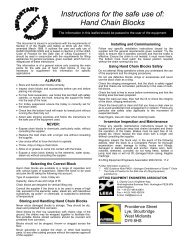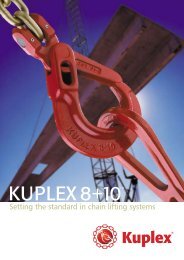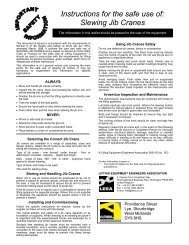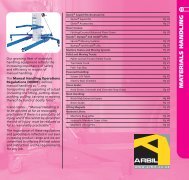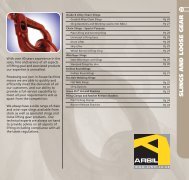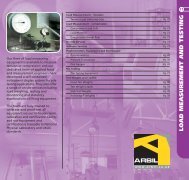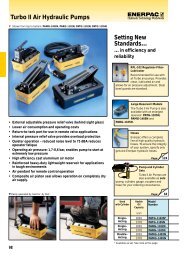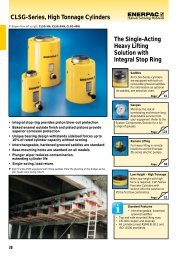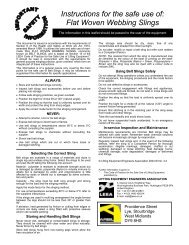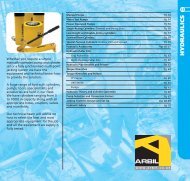Instructions for the safe use of: Chain Slings - Arbil Lifting Gear
Instructions for the safe use of: Chain Slings - Arbil Lifting Gear
Instructions for the safe use of: Chain Slings - Arbil Lifting Gear
Create successful ePaper yourself
Turn your PDF publications into a flip-book with our unique Google optimized e-Paper software.
<strong>Instructions</strong> <strong>for</strong> <strong>the</strong> <strong>safe</strong> <strong>use</strong> <strong>of</strong>:<strong>Chain</strong> <strong>Slings</strong>The in<strong>for</strong>mation in this leaflet should be passed to <strong>the</strong> <strong>use</strong>r <strong>of</strong> <strong>the</strong> equipmentThis document is issued in accordance with <strong>the</strong> requirements <strong>of</strong>Section 6 <strong>of</strong> <strong>the</strong> Health and Safety at Work etc Act 1974,amended March 1988. It outlines <strong>the</strong> care and <strong>safe</strong> <strong>use</strong> <strong>of</strong>general purpose CHAIN SLINGS and is based on Section 13 <strong>of</strong><strong>the</strong> LEEA Code <strong>of</strong> Practice <strong>for</strong> <strong>the</strong> Safe Use <strong>of</strong> <strong>Lifting</strong>Equipment.* It should be read in conjunction with <strong>the</strong>requirements <strong>for</strong> general purpose slinging practice, givenoverleaf, which <strong>for</strong>m an integral part <strong>of</strong> <strong>the</strong>se instructions.This in<strong>for</strong>mation is <strong>of</strong> a general nature only covering <strong>the</strong> mainpoints <strong>for</strong> <strong>the</strong> <strong>safe</strong> <strong>use</strong> <strong>of</strong> chain slings. It may be necessary tosupplement this in<strong>for</strong>mation <strong>for</strong> specific applications.ALWAYS:• Store and handle chain slings correctly.• Inspect chain slings and accessories be<strong>for</strong>e <strong>use</strong> and be<strong>for</strong>eplacing into storage.• Follow <strong>safe</strong> slinging practices, as given overleaf.• Fit slings carefully, protect <strong>the</strong>m from sharp edges andposition hooks to face outward from <strong>the</strong> load.• Apply <strong>the</strong> correct mode factor <strong>for</strong> <strong>the</strong> slinging arrangement.• Back hook free legs onto <strong>the</strong> master link.NEVER:• Attempt to shorten a sling leg o<strong>the</strong>r than by means <strong>of</strong> anintegral chain clutch.• Force, hammer or wedge chain slings or <strong>the</strong>ir fittings intoposition.• Lift on <strong>the</strong> point <strong>of</strong> a hook.• Expose chain slings to chemicals, particularly acidicconditions, without consulting <strong>the</strong> supplier.• Use chain slings at temperatures above 200°C or belowminus 40°C without consulting <strong>the</strong> supplier.• Shock load chain slings.Store chain slings on a rack and not lying on <strong>the</strong> ground. Thestorage area should be dry, clean and free <strong>of</strong> any contaminateswhich may harm <strong>the</strong> sling.Do not alter, modify or repair a chain sling but refer suchmatters to a Competent Person.Never galvanise or subject a chain sling to any o<strong>the</strong>r platingprocess without <strong>the</strong> express approval <strong>of</strong> <strong>the</strong> supplier.Using <strong>Chain</strong> <strong>Slings</strong> SafelyDo not attempt lifting operations unless you understand <strong>the</strong> <strong>use</strong><strong>of</strong> <strong>the</strong> equipment, <strong>the</strong> slinging procedures and <strong>the</strong> mode factorsto be applied.Do not <strong>use</strong> defective slings or accessories.Do not <strong>for</strong>ce, hammer or wedge chain slings or fittings intoposition; <strong>the</strong>y must fit freely. Check <strong>the</strong> correct engagement <strong>of</strong>fittings and appliances.Position hooks <strong>of</strong> multi-leg slings facing outward from <strong>the</strong> load.Do not lift on <strong>the</strong> point <strong>of</strong> <strong>the</strong> hook and ensure that <strong>the</strong> chain isnot twisted or knotted.Back hook free legs to <strong>the</strong> master link to avoid lashing legswhich might accidentally become engaged or o<strong>the</strong>rwisebecome a hazard.Take <strong>the</strong> load steadily and avoid shock loads.Do not leave suspended loads unattended. In an emergencycordon <strong>of</strong>f <strong>the</strong> area.In-service Inspection and MaintenanceMaintenance requirements are minimal. Keep chain slingsclean and protect from corrosion.Regularly inspect chain slings and, in <strong>the</strong> event <strong>of</strong> <strong>the</strong> followingdefects, refer <strong>the</strong> sling to a Competent Person <strong>for</strong> thoroughexamination: illegible markings; distortion <strong>of</strong> fittings; worn,stretched, bent or twisted links; ineffective <strong>safe</strong>ty catches; cuts,nicks, gouges, cracks, corrosion, heat discolouration or anyo<strong>the</strong>r defect apparent to <strong>the</strong> chain or fittings.Selecting <strong>the</strong> Correct Sling<strong>Chain</strong> slings are available in a range <strong>of</strong> material grades, sizesand assemblies. Select <strong>the</strong> slings to be <strong>use</strong>d and plan <strong>the</strong> lifttaking <strong>the</strong> following into account:Type <strong>of</strong> sling to be <strong>use</strong>d - endless, single, two, three or four leg.Capacity - <strong>the</strong> sling must be both long enough and strongenough <strong>for</strong> <strong>the</strong> load and <strong>the</strong> slinging method.Apply <strong>the</strong> mode factor <strong>for</strong> <strong>the</strong> slinging method.If adjustment <strong>of</strong> <strong>the</strong> leg length is necessary select a sling withchain shortening clutches.For <strong>use</strong> at temperatures exceeding 200°C or below minus 40°Crefer to <strong>the</strong> suppliers instructions.Where slings may come into contact with chemicals, particularlyacids or acidic fumes, consult <strong>the</strong> supplier.**In <strong>the</strong> case <strong>of</strong> multi-leg slings <strong>the</strong> angle between <strong>the</strong> legsshould not be less than 30° or exceed <strong>the</strong> maximum marked.Multi-leg slings exert a gripping <strong>for</strong>ce on <strong>the</strong> load whichincreases as <strong>the</strong> angle between <strong>the</strong> legs increases and thismust be taken into account.Storing and Handling <strong>Chain</strong> <strong>Slings</strong>Never return damaged or contaminated slings to storage. Theyshould be dry, clean and protected from corrosion.© <strong>Lifting</strong> Equipment Engineers Association 2004 SI No. 1.2Fur<strong>the</strong>r in<strong>for</strong>mation is given in:** HSE Guidance Note PM 39 - Hydrogen Embrittlement <strong>of</strong> Grade T<strong>Chain</strong>* The Code <strong>of</strong> Practice <strong>for</strong> <strong>the</strong> Safe Use <strong>of</strong> <strong>Lifting</strong> Equipment,published by:LIFTING EQUIPMENT ENGINEERS ASSOCIATION3, Osprey Court, Kingfisher Way,Hinchingbrooke Business Park, Huntingdon PE29 6FNUnited KingdomTel: + 44 (0) 1480 432801Fax: + 44 (0) 1480 436314E-mail: mail@leea.co.ukProvidence StreetLye, StourbridgeWest MidlandsDY9 8HS
GENERAL PURPOSE SLINGING PRACTICEThe following in<strong>for</strong>mation is based on Section 1 - Appendix 1.5<strong>of</strong> <strong>the</strong> LEEA Code <strong>of</strong> Practice <strong>for</strong> <strong>the</strong> Safe Use <strong>of</strong> <strong>Lifting</strong>Equipment.* It should be read in conjunction with <strong>the</strong>instructions <strong>for</strong> <strong>the</strong> <strong>safe</strong> <strong>use</strong>, given overleaf, <strong>of</strong> which it <strong>for</strong>ms anintegral part and with any specific instructions issued by <strong>the</strong>supplier.This in<strong>for</strong>mation is <strong>of</strong> a general nature only covering <strong>the</strong> mainpoints <strong>for</strong> <strong>the</strong> <strong>safe</strong> <strong>use</strong> <strong>of</strong> various types <strong>of</strong> slings <strong>for</strong> generallifting purposes.ALWAYS:• Plan <strong>the</strong> lift, establish <strong>the</strong> weight <strong>of</strong> <strong>the</strong> load and prepare <strong>the</strong>landing area ensuring that it will take <strong>the</strong> weight.• Check slings and equipment are free <strong>of</strong> damage, <strong>use</strong>slings/slinging methods suitable <strong>for</strong> <strong>the</strong> load and protectslings from sharp edges and corners.• Attach <strong>the</strong> sling securely to <strong>the</strong> load and appliance andposition hooks to face outwards.• Ensure <strong>the</strong> load is balanced and will not tilt or fall.• Keep fingers, toes etc clear when tensioning slings and whenlanding loads.• Ensure that <strong>the</strong> load is free to be lifted.• Make a trial lift and trial lower.NEVER:• Use damaged slings or accessories.• Twist, knot or tie slings.• Hammer slings into position.• Overload slings due to <strong>the</strong> weight <strong>of</strong> <strong>the</strong> load or <strong>the</strong> mode <strong>of</strong><strong>use</strong>.• Trap slings when landing <strong>the</strong> load.• Drag slings over floors etc or attempt to pull trapped slingsfrom under loads.• Allow personnel to ride on loads.Sling Configurations and Rating<strong>Slings</strong> are available in single, two, three and four leg or endless<strong>for</strong>m. In practice it will be found that chain, wire rope and fibrerope slings are available in any <strong>of</strong> <strong>the</strong>se configurations but thatflat woven webbing is limited to single leg and endless whilstroundslings are only supplied in endless <strong>for</strong>m. The maximumload that a sling may lift in <strong>use</strong> will be governed by <strong>the</strong> slingingarrangement (mode <strong>of</strong> <strong>use</strong>) and may vary from <strong>the</strong> markedSWL.** In <strong>the</strong> case <strong>of</strong> textile slings <strong>the</strong> SWL <strong>for</strong> <strong>the</strong> variousmodes <strong>of</strong> <strong>use</strong> is usually given on <strong>the</strong> in<strong>for</strong>mation label. In o<strong>the</strong>rcases it is necessary to multiply <strong>the</strong> marked SWL by a modefactor.***The following three simple rules will ensure that <strong>the</strong> sling is notoverloaded. In some cases this will mean that <strong>the</strong> sling will beunder utilised although this is unlikely to hinder <strong>the</strong> <strong>use</strong>r unduly.Where <strong>the</strong> maximum utilisation is required reference should bemade to a Competent Person who understands <strong>the</strong> factorsinvolved and who can per<strong>for</strong>m <strong>the</strong> necessary calculations.(1) For straight lift never exceed <strong>the</strong> marked SWL and in <strong>the</strong>case <strong>of</strong> multi-leg slings <strong>the</strong> specified angle or range <strong>of</strong>angles.(2) When using slings in choke hitch multiply <strong>the</strong> marked SWLby 0.8 to obtain <strong>the</strong> reduced maximum load <strong>the</strong> sling maylift ie reduce <strong>the</strong> <strong>safe</strong> working load by 20%.(3) With multi-leg slings, when using less than <strong>the</strong> full number<strong>of</strong> legs, reduce <strong>the</strong> maximum load in proportion to <strong>the</strong>number <strong>of</strong> legs in <strong>use</strong>. Simply multiply <strong>the</strong> marked SWL by<strong>the</strong> number <strong>of</strong> legs in <strong>use</strong> expressed as a fraction <strong>of</strong> <strong>the</strong>total thus: one leg <strong>of</strong> a two leg sling = ½ marked SWL,three legs <strong>of</strong> a four leg sling = ¾ marked SWL and so on.Operative Training<strong>Slings</strong> should only be <strong>use</strong>d by trained operatives whounderstand <strong>the</strong> methods <strong>of</strong> rating and application <strong>of</strong> modefactors.****Safe <strong>use</strong> <strong>of</strong> <strong>Slings</strong>o Good slinging practice must ensure that <strong>the</strong> load is as <strong>safe</strong>and secure in <strong>the</strong> air as it was on <strong>the</strong> ground and that noharm is done to <strong>the</strong> load, lifting equipment, o<strong>the</strong>r property orpersons.o Establish <strong>the</strong> weight <strong>of</strong> <strong>the</strong> load, ensure <strong>the</strong> lifting method issuitable and inspect <strong>the</strong> sling and attachments <strong>for</strong> obviousdefects. Prepare <strong>the</strong> landing area making sure <strong>the</strong> floor isstrong enough to take <strong>the</strong> load. Follow any specificinstructions from <strong>the</strong> supplier.o Ensure <strong>the</strong> lifting point is over <strong>the</strong> centre <strong>of</strong> gravity. Any looseparts <strong>of</strong> <strong>the</strong> load should be removed or secured. Secure <strong>the</strong>sling firmly to <strong>the</strong> load by hooks onto lifting points or shacklesetc. The sling must not be twisted, knotted or kinked in anyway.o Use packing to prevent damage to <strong>the</strong> sling from corners oredges and to protect <strong>the</strong> load.o Do not exceed <strong>the</strong> SWL or rated angle. Any choke anglemust not exceed 120° and any basket 90°.o Do not hammer, <strong>for</strong>ce or wedge slings or accessories intoposition; <strong>the</strong>y must fit freely.o When attaching more than one sling to <strong>the</strong> hook <strong>of</strong> <strong>the</strong>appliance <strong>use</strong> a shackle to join <strong>the</strong> slings and avoidovercrowding <strong>the</strong> hook.o Use an established code <strong>of</strong> signals to instruct <strong>the</strong> cranedriver.o Ensure <strong>the</strong> load is free to be lifted and not, <strong>for</strong> example,bolted down.o Check that <strong>the</strong>re are no overhead obstacles such as powerlines.o Keep fingers, toes etc clear ensuring <strong>the</strong>y do not becometrapped when lifting, lowering or controlling loads.o Make a trial lift by raising <strong>the</strong> load a little to ensure it isbalanced, stable and secure and if not lower it and adjust <strong>the</strong>slinging arrangement.o Where appropriate <strong>use</strong> tag lines to control <strong>the</strong> load.o Except where special provision is made, do not allow anyoneto pass under or ride upon <strong>the</strong> load. The area should be keptclear.o Make a trial set down, ensure <strong>the</strong> sling will not becometrapped and <strong>the</strong> load will not tip when <strong>the</strong> slings are released.Use supports which are strong enough to sustain <strong>the</strong> loadwithout crushing.o Never drag slings over floors etc or attempt to drag a trappedsling from under a load.o Never <strong>use</strong> a sling to drag a load.o Place <strong>the</strong> hooks <strong>of</strong> free legs back onto <strong>the</strong> master link andtake care to ensure that empty hooks do not becomeaccidentally engaged.o Never <strong>use</strong> slings in contact with chemicals or heat without <strong>the</strong>manufacturers approval.o Never <strong>use</strong> damaged or contaminated slings.o On completion <strong>of</strong> <strong>the</strong> lift return all equipment to properstorage.Fur<strong>the</strong>r in<strong>for</strong>mation is given in:* LEEA Code <strong>of</strong> Practice <strong>for</strong> <strong>the</strong> Safe Use <strong>of</strong> <strong>Lifting</strong>Equipment.** BS 6166 Part 1 - <strong>Lifting</strong> <strong>Slings</strong>, Methods <strong>of</strong> Rating.*** BS 6166 Part 3 - Selection and Safe Use <strong>of</strong> <strong>Lifting</strong> <strong>Slings</strong><strong>for</strong> Multi-purposes.**** HSE Guidance Note GS39 - Training <strong>of</strong> Crane Drivers andSlingers.Various British Standards covering individual products.SI GSP 1.1 (2000)



